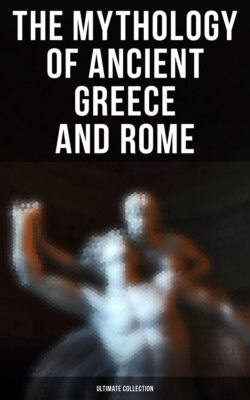Читать книгу The Mythology of Ancient Greece and Rome - Ultimate Collection - Homer - Страница 30
На сайте Литреса книга снята с продажи.
II. OTHER DEITIES OF OLYMPUS
ОглавлениеThe Graces (or Char’i tes) presided over the feast and the dance, all the gracious and festive side of social intercourse. For the Greek ideal demanded that men's everyday life, no less than their worship, should be ruled by grace and beauty, and the deities who brought this harmony to life were fittingly conceived as the daughters of no less a one than Zeus. They were three in number and were represented nude or in transparent drapery, adorned with spring flowers and roses.
The Nine Muses, daughters of Zeus and Mnemosyne (ne mos’i nē, Memory), presided, each over a distinct form of poetry, art, or science. They formed the chorus of Apollo, the god of music, and with him haunted the heights of Parnassus or Helicon, or danced about the springs of Pieria. Their names, their functions, and their emblems are as follows: Clio, the muse of history, holds a roll of writing; Cal li’ope, the muse of epic poetry, holds a tablet and pen; Mel pom’e ne, the muse of tragedy, holds a tragic mask; Tha li’a, the muse of comedy, holds a comic mask or wears the distinctive costume of the actor of comedy; Terp sich’o re, the muse of the choral lyric and the dance, wears a long garment and holds a lyre; Er’a to, the muse of love poetry, wears a thin garment and holds a lyre; Eu ter'pe, the muse of flute music, holds a double flute; U ra’ni a, the muse of astronomy, holds a globe; Po lym’ni a, the muse of religious poetry or the pantomime, is represented in an attitude of meditation. To the Muses poets offered prayers and vows: "Fortunate is he whomsoever the Muses love, and sweet flows his voice from his lips." (Homeric Hymn to the Muses)
Fig. 36. Clio.
The Three Fates held in their hands the thread of life, and when man's allotted life was spun, the shears of the fates cut it off. Their names are given in the little verse from Lowell's Villa Franca: "Spin, spin, Clotho, spin! Lach’e sis, twist! and At’ro pus, sever!" They tell of the past, present, and future.
Fig. 37. Thalia.
Nem’e sis, a darkly mysterious power that overshadowed even the gods themselves, for evil done or for excess of pride brought divine vengeance from which there was no hope of escape.
The winds were under the control of Æ’o lus, to whom Zeus gave the power to rouse or to quiet them. In a vast cave in one of the volcanic Lipari Islands, he and his twelve boisterous children, the winds, lived a life of feasting and merriment. There they struggle against their prison doors and cause mighty rumbling of the mountain. If let loose, Vergil says, they would sweep away earth and sea and sky in their destructive course. Bo’re as is the wild north wind; Zeph’y rus is the gentle west wind.
Fig. 38. Terpsichore.
